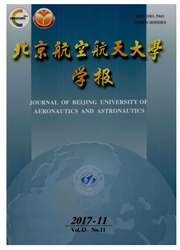

 中文摘要:
中文摘要:
舵机动力学对舵系统颤振有最直接影响,其动力学模型的准确建立是颤振分析的关键。以某电动伺服舵系统为对象,分别建立了电机、减速器及控制回路模型。基于其地面振动试验(GVT)数据特征,考虑了减速器中零部件间隙及滚珠丝杠间接触刚度2类非线性因素。动力学仿真结果复现了试验现象,证明了接触刚度和间隙对该伺服舵系统动力学特征的主导作用。在颤振分析中,对比了接触刚度和常数刚度2种假设下,舵机在不同阶跃角指令下的舵偏角响应。发现常数刚度下舵系统仅存在极限环(LCO)和失稳2个域,临界速度不会随间隙大小而变化;而接触刚度下存在稳定、LCO和失稳3个域,且相同风速下,其临界指令角较常数刚度假设更高,但其临界速度却会随间隙增大而减小,甚至小于常数刚度假设,应引起足够重视。
 英文摘要:
英文摘要:
Dynamics of an actuator has a direct impact on the flutter characteristics of a fin structure.Thus it is important to build the dynamic model of the fin-actuator system precisely before a flutter analysis. A typical fin-actuator system is investigated by constructing its motor model,reducer model and controller model,respectively. Based on the characteristics of the ground vibration test( GVT) data,two nonlinear factors are considered including the contact stiffness between the screw and the balls,as well as the freeplay. Simulation results reproduce what were seen in the test. It is found that the contact stiffness and freeplay dominate the dynamic characteristics of the fin-actuator system. In the flutter analysis,the angular responses of the actuator stimulated by different angular step commands under both contact stiffness assumption and constant stiffness assumption are compared. The results show that a limit cycle ossllation( LCO) domain and an unstable domain exist under the constant stiffness. Its critical velocities do not vary with the freeplays. However,besides the LCO and unstable domains,a stable domain appears under the contact stiffness. At a specific flow velocity,its critical command angle is higher than the one under constant stiffness. But its critical velocity decreases as the freeplay increases,and even reaches a lower level than the critical velocity under constant stiffness. Enough attention should be paid to this issue.
 同期刊论文项目
同期刊论文项目
 同项目期刊论文
同项目期刊论文
 Aeroservoelastic model modification and uncertainty quantification with bayesian posteriori estimati
Aeroservoelastic model modification and uncertainty quantification with bayesian posteriori estimati Aeroelastic two-level optimization for preliminary design of wing structures considering robust cons
Aeroelastic two-level optimization for preliminary design of wing structures considering robust cons 期刊信息
期刊信息
